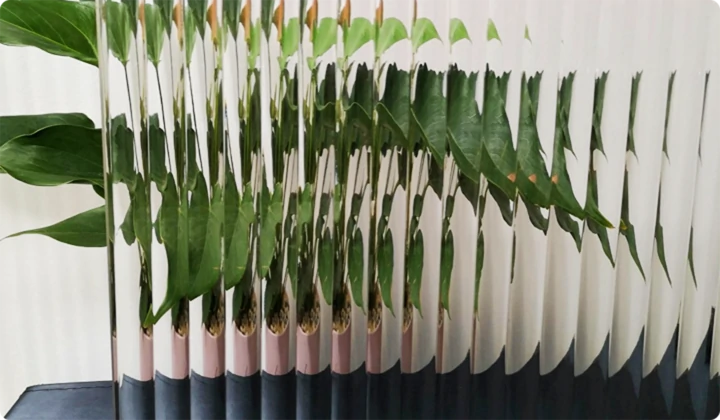The Beauty and Versatility of Ornamental Glass
Ornamental glass, with its myriad forms and artistic expressions, has captivated humanity for centuries. Known for its aesthetic appeal, ornamental glass is more than just a decorative element; it serves as a functional art form that elevates spaces, tells stories, and reflects cultural identities. From stained glass windows in ancient cathedrals to contemporary glass sculptures and installations, this versatile medium continues to evolve and inspire.
Historical Significance
The history of ornamental glass dates back to ancient civilizations, where glass was initially used for practical applications. The Egyptians are credited with some of the earliest glass-making techniques, creating beads and small vessels around 2500 BC. However, it wasn't until the rise of the Roman Empire that glass-blowing techniques advanced, allowing artisans to produce more intricate and decorative items. The Roman glassmakers introduced innovations that transformed glass into an art form, paving the way for what would become known as ornamental glass.
In the Middle Ages, stained glass windows emerged as a prominent decorative feature in churches and cathedrals. These stunning pieces of art not only illuminated sacred spaces but also narrated biblical stories, serving as tools for religious education during a time when literacy was not widespread. The intricate designs and vibrant colors of these windows transported viewers into a realm of spirituality and wonder, making ornamental glass an integral part of religious architecture.
Artistic Expression
As the art of glass-making continued to evolve, so did the techniques and styles associated with ornamental glass
. The Renaissance period saw a revival of interest in glass, with artists experimenting with new methods, including glass etching and engraving. This period gave birth to beautifully crafted glassware, vases, and light fixtures that showcased the skill and creativity of the artisans.
In more recent times, the 20th century ushered in modernism, which shifted the focus to contemporary interpretations of ornamental glass. Artists such as Dale Chihuly brought glass art into the mainstream with his large-scale installations that blend color, form, and light. His work not only emphasizes the beauty of glass but also challenges traditional perceptions by using it as a medium to create immersive environments.
ornamental glass
Contemporary Applications
Today, ornamental glass is not limited to fine art or traditional craftsmanship; it has found its way into various domains, including architecture, interior design, and even fashion. Glass walls and facades in modern buildings utilize ornamental glass to create visually stunning exteriors while providing natural light and enhancing energy efficiency. Interior designers incorporate glass elements, such as decorative partitions and artistic light fixtures, to add elegance and sophistication to residential and commercial spaces.
Fashion designers have also embraced ornamental glass, using it as an accessory or even as part of garments. Glass beads, for instance, are popular in jewelry design, allowing for the creation of stunning pieces that catch the light and draw attention. This fusion of art and fashion reflects the versatility of ornamental glass and its ability to transcend boundaries.
Sustainability and Future Directions
As society increasingly emphasizes sustainability, the glass industry is adapting by exploring eco-friendly practices. Recycled glass is becoming a popular choice for ornamental purposes, allowing artists and designers to create beautiful pieces while minimizing waste. This shift not only contributes to environmental conservation but also adds unique character to the artworks produced.
Looking ahead, the future of ornamental glass is bright. The integration of technology, such as 3D printing and digital design, is opening up new avenues for creativity. Artists can now experiment with complex forms and customizable designs that were once unimaginable. The potential for interactive installations, where viewers can engage with the artwork, is also on the rise, promising to redefine the relationship between art and audience.
Conclusion
Ornamental glass remains a vital and thriving art form that continues to evolve alongside cultural advancements and technological innovations. Its historical significance, aesthetic beauty, and versatility make it a cherished medium in the world of art and design. As we look to the future, the ways in which ornately crafted glass captures the imagination and enriches our lives will undoubtedly expand, providing endless opportunities for creativity and expression. Whether through classic stained glass or innovative contemporary designs, ornamental glass will continue to enchant and inspire generations to come.
 Afrikaans
Afrikaans  Albanian
Albanian  Amharic
Amharic  Arabic
Arabic  Armenian
Armenian  Azerbaijani
Azerbaijani  Basque
Basque  Belarusian
Belarusian  Bengali
Bengali  Bosnian
Bosnian  Bulgarian
Bulgarian  Catalan
Catalan  Cebuano
Cebuano  Corsican
Corsican  Croatian
Croatian  Czech
Czech  Danish
Danish  Dutch
Dutch  English
English  Esperanto
Esperanto  Estonian
Estonian  Finnish
Finnish  French
French  Frisian
Frisian  Galician
Galician  Georgian
Georgian  German
German  Greek
Greek  Gujarati
Gujarati  Haitian Creole
Haitian Creole  hausa
hausa  hawaiian
hawaiian  Hebrew
Hebrew  Hindi
Hindi  Miao
Miao  Hungarian
Hungarian  Icelandic
Icelandic  igbo
igbo  Indonesian
Indonesian  irish
irish  Italian
Italian  Japanese
Japanese  Javanese
Javanese  Kannada
Kannada  kazakh
kazakh  Khmer
Khmer  Rwandese
Rwandese  Korean
Korean  Kurdish
Kurdish  Kyrgyz
Kyrgyz  Lao
Lao  Latin
Latin  Latvian
Latvian  Lithuanian
Lithuanian  Luxembourgish
Luxembourgish  Macedonian
Macedonian  Malgashi
Malgashi  Malay
Malay  Malayalam
Malayalam  Maltese
Maltese  Maori
Maori  Marathi
Marathi  Mongolian
Mongolian  Myanmar
Myanmar  Nepali
Nepali  Norwegian
Norwegian  Norwegian
Norwegian  Occitan
Occitan  Pashto
Pashto  Persian
Persian  Polish
Polish  Portuguese
Portuguese  Punjabi
Punjabi  Romanian
Romanian  Russian
Russian  Samoan
Samoan  Scottish Gaelic
Scottish Gaelic  Serbian
Serbian  Sesotho
Sesotho  Shona
Shona  Sindhi
Sindhi  Sinhala
Sinhala  Slovak
Slovak  Slovenian
Slovenian  Somali
Somali  Spanish
Spanish  Sundanese
Sundanese  Swahili
Swahili  Swedish
Swedish  Tagalog
Tagalog  Tajik
Tajik  Tamil
Tamil  Tatar
Tatar  Telugu
Telugu  Thai
Thai  Turkish
Turkish  Turkmen
Turkmen  Ukrainian
Ukrainian  Urdu
Urdu  Uighur
Uighur  Uzbek
Uzbek  Vietnamese
Vietnamese  Welsh
Welsh  Bantu
Bantu  Yiddish
Yiddish  Yoruba
Yoruba  Zulu
Zulu 

